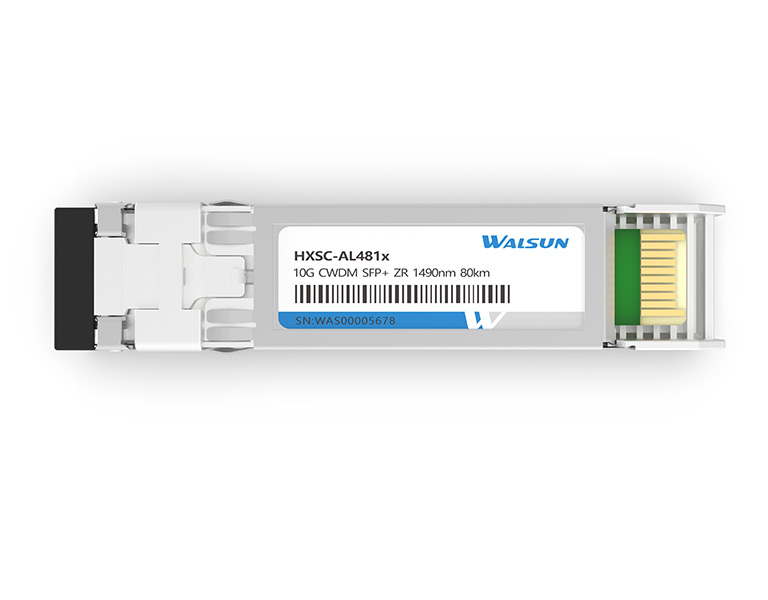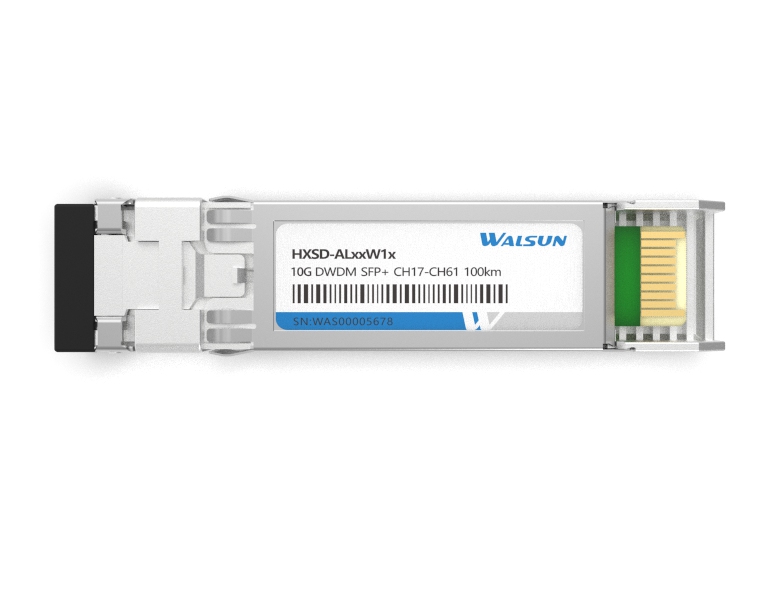

 Knowledge Base +
Knowledge Base +  2024.03.04
2024.03.04As optical communication technology rapidly advances, 10G CWDM/DWDM SFP+ transceivers have become essential components in modern networking solutions. These transceivers facilitate high-speed data transmission over optical fibers by utilizing either Coarse Wavelength Division Multiplexing (CWDM) or Dense Wavelength Division Multiplexing (DWDM) technologies. In this article, we'll delve into the characteristics and applications of both 10G CWDM and DWDM SFP+ transceivers, aiming to provide insights into which solution best aligns with your specific networking requirements.
What Are 10G CWDM/DWDM SFP+ Transceivers?
10G CWDM SFP+ Transceiver
The 10G CWDM SFP+ transceivers are optical devices designed for efficient data transmission in fiber optic networks. Leveraging CWDM technology, they enable simultaneous transmission of multiple optical signals across different wavelengths over a single optical fiber. This enhances the fiber's capacity, allowing for swift data transfer. Additionally, these transceivers offer a transmission distance ranging from 20km to 80km, making them suitable for various network configurations and requirements.

Figure 1: 10G CWDM SFP+ Transceiver
10G DWDM SFP+ Transceiver
The 10G DWDM SFP+ Transceiver plays a crucial role in fiber optic networks, utilizing DWDM technology. This innovative approach allows multiple optical signals to travel concurrently down a single optical fiber, each with its own distinct wavelength. Consequently, significant amounts of data can be transmitted efficiently over a single fiber. Moreover, these transceivers support transmission distances of up to 80km, ensuring their suitability for a wide range of network configurations and requirements.

Figure 2: 10G DWDM SFP+ Transceiver
10G CWDM SFP+ vs. 10G DWDM SFP+ Difference
Wavelength Spacing:
CWDM (Coarse Wavelength Division Multiplexing): CWDM typically uses fewer channels with wider wavelength spacing. The standard CWDM grid has channels separated by approximately 20 nm, and it commonly operates in the 1270 nm to 1610 nm wavelength range.
DWDM (Dense Wavelength Division Multiplexing): DWDM uses a denser grid of channels with narrower wavelength spacing. DWDM channels are usually separated by 0.8 nm (100 GHz grid) or 0.4 nm (50 GHz grid), allowing for more channels in the same wavelength range.
Number of Channels:
CWDM: Typically supports fewer channels, often up to 18 wavelengths on the ITU-T G.694.2 grid.
DWDM: Supports a larger number of channels, potentially up to 80 or more wavelengths on the ITU-T G.694.1 grid.
Wavelength Range:
CWDM: Operates in the lower frequency range, commonly within the 1270 nm to 1610 nm range.
DWDM: Operates in a broader frequency range, covering a wider spectrum, often in the 1525 nm to 1565 nm range.
Application Distance:
CWDM: Typically used for shorter-distance applications, such as metro and access networks. The distance can vary, but it is generally up to 80 kilometers.
DWDM: Suited for longer-distance applications, including long-haul and ultra-long-haul networks. DWDM can support transmission over several hundred kilometers to thousands of kilometers.
Spectral Efficiency:
CWDM: Generally considered to have lower spectral efficiency due to wider wavelength spacing.
DWDM: Offers higher spectral efficiency as a result of the narrower wavelength spacing, allowing more channels to be multiplexed in the same wavelength range.
CWDM/DWDM SFP+ Transceivers Buying Guide
When building a CWDM/DWDM system, CWDM and DWDM SFP transceivers are usually in high demand, since the OEM SFP optical transceivers are costly, choosing a reliable third-party CWDM/DWDM SFP+ supplier is vital.
Performance and price are always the most important considerations. Walsun 10G CWDM/DWDM SFP+ transceivers adopt industry-leading laser components. In Walsun factory, all CWDM/DWDM SFP+ transceivers must be rigorously tested on performance before they are put into service. To ensure compatibility, the SFPs also need to be tested on the target vendors’ switches. Walsun 10G CWDM/DWDM SFP+ transceivers are tested and promised to be compatible with most mainstream vendors, including Cisco, Juniper, Arista, etc.
With the guarantee of advanced technology, the price of Walsun CWDM/DWDM SFPs is also competitive. For bulk orders, more attractive prices are available, welcome to consult via sales@walsun.com.
Additional Learning Hub Resources
What is the difference between active and passive SFP+ cables
Subscribe to the newsletter
for all the latest updates.
2-5# Building, Tongfuyu Industrial Zone, Aiqun Road, Shiyan Street, Baoan District, Shenzhen. China
